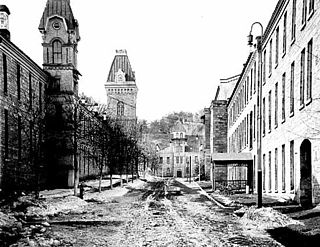
The Minnesota Territorial Prison, later the Minnesota State Prison, was a prison in Stillwater, Minnesota, United States, in operation from 1853 to 1914. Construction of the prison began in 1851, shortly after Minnesota became a territory. The prison was replaced by the Minnesota Correctional Facility – Stillwater in nearby Bayport. Most of the original prison's structures were demolished in 1936, leaving only the 1853 Warden's House and a manual labor complex that had been constructed 1884–1898. The surviving factory buildings were listed on the National Register of Historic Places in 1982 for having state-level significance in the themes of industry and social history. The historic site, long since unused, was destroyed by arson on September 3, 2002. It was formally delisted from the National Register in 2005.
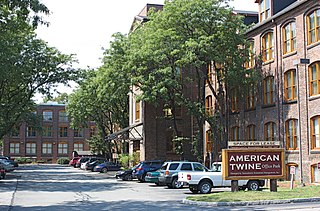
The American Net and Twine Company Factory is a historic factory at 155 2nd Street in Cambridge, Massachusetts. It was built in 1875 by the nation's first manufacturer of cotton fishing nets. It now houses corporate office space. It was listed on the National Register of Historic Places in 1982.

The New England Confectionery Company Factory, also known as the NECCO Candy Factory, is an historic factory complex at 250 Massachusetts Avenue in Cambridge, Massachusetts. The property is now owned by DFS Advisors, and is under long-term lease to Novartis. The complex, which includes the factory building, a power plant, and a modern (2003) parking garage, occupies most of an entire city block bounded by Massachusetts Avenue, Cross Street, Albany Street, and Lansdowne Street. The Moderne-style building was constructed of reinforced concrete, faced predominantly with beige brick and trimmed with limestone. On some facades smooth concrete predominates as the finish surface. The building had a water tower that was painted to resemble a roll of Necco Wafers; during the alterations of the property for use by Novartis, the water tower was retained, and is now painted with a DNA pattern in pastel colors. The building was listed on the National Register of Historic Places in 2005.
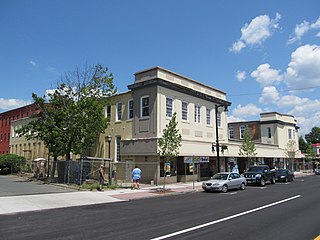
The United States Whip Company Complex or "United States Line Company Complex" is a historic factory located in Westfield, Massachusetts. It was owned and operated by one of the whip-making businesses that led Westfield to become widely known as "Whip City". United States Whip, created in 1892 by the consolidation of several local manufacturers, was the world's largest manufacturer of whips. The factory complex was listed individually on the National Register of Historic Places in 1983, and as part of an expanded Westfield Center Historic District in 2013.

Westfield Whip Manufacturing Company is a historic factory at 360 Elm Street in Westfield, Massachusetts. Built about 1887, it is the best preserved of Westfield's extant whip factory buildings. It is also home to the last surviving business of the many whipmakers that once operated in Westfield. The factory was listed on the National Register of Historic Places in 1985, and included in an expansion of the Westfield Center Historic District in 2013.
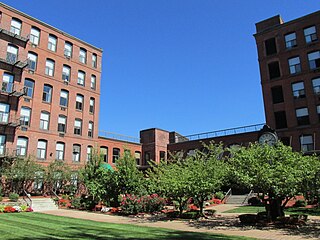
The Milton-Bradley Company is a historic former factory complex at Park, Cross, and Willow Streets in Springfield, Massachusetts. The factory was built beginning in about 1880, and expanded over the next decades to include a variety of brick multi-story buildings that are relatively utilitarian in appearance. When built, the property belonged to George Tapley, a principal in the Taylor and Tapley Manufacturing Company and a childhood friend of Milton Bradley. Bradley had entered the toy business in the 1860s, and moved his company to Tapley's premises in 1882.

The Arlington Mills Historic District encompasses a major 19th century textile manufacturing complex in Lawrence and Methuen, Massachusetts. Developed between 1865 and 1925, it was one of the state's largest textile operations at its height. At the time of its listing on the National Register of Historic Places in 1985, the mill complex was owned by Malden Mills.
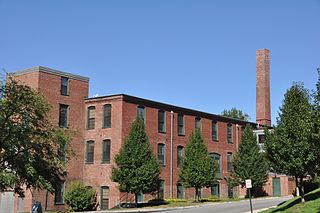
The Walker Body Company Factory is a historic factory complex on Oak Street at River Court in Amesbury, Massachusetts. It has been converted to residential use.
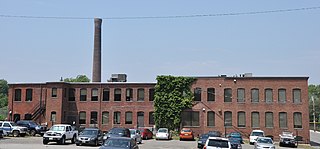
The American Watch Tool Company is a historic factory complex at 169 Elm Street in Waltham, Massachusetts. The company was founded in 1877 as a spin-off from the successful American Watch Company, and was used for the production of watchmaking tools until 1904. The four-building complex traces the evolutionary history of this business. The factory was listed on the National Register of Historic Places in 1989.

The United States Watch Company is a historic factory complex at 260 Charles Street in Waltham, Massachusetts. Built in 1886 and enlarged in 1901, it represents one of the most successful spinoffs of the American Waltham Watch Company, Waltham's dominant watchmaker of the late 19th century. When the complex was listed on the National Register of Historic Places in 1989, it was the last watch factory left in the city.

The Worcester Bleach and Dye Works is a historic factory complex at 60 Fremont Street in Worcester, Massachusetts. It consists of a pair of primarily brick factory buildings, one of which was built in 1909, and the other built later, between 1911 and 1922, for the named company, which was a major local manufacturer of thread. After the Bleach and Dye Works closed its doors in 1938, the complex has seen a succession of other owners.

The Central Mills Historic District encompasses a historic mill complex on the Quinebaug River in central Southbridge, Massachusetts. Located at the corner of Foster and North Streets, the site consists of three brick buildings, the oldest of which has portions dating to 1837. Despite being extensively rebuilt in the early 20th century, the complex has an appearance that is more typical of 19th century mills.

The Strouse, Adler Company Corset Factory is a historic factory complex at 78-84 Olive Street in New Haven, Connecticut. Developed between 1876 and 1923, it was the largest and oldest of the city's several corset manufacturers, and remained in continuous operation for that purpose until 1998. The complex was listed on the National Register of Historic Places in 2002. It has since been converted into residential use.

The Sanford Whip Company is a historic factory located at 330 Elm Street in Westfield, Massachusetts. Built in 1883, it was owned and operated by one of the whip-making business that led Westfield to become widely known as "Whip City". The building for many years housed a novelty toy manufacturer after the market for whips declined in the early decades of the 20th century. The factory was listed individually on the National Register of Historic Places in 2008, and as part of an expanded Westfield Center Historic District in 2013. It has been converted into affordable housing space.

The Page Belting Company Mills is a historic mechanical belt mill complex at 26 Commercial Street in Concord, New Hampshire, United States. Located north of Concord's central business district near Horseshoe Pond, the complex consists of four brick buildings built between 1892 and 1906 for one of the city's major businesses. The mill complex, now converted to residential and other uses, was listed on the National Register of Historic Places in 2002.

The Hoyt Shoe Factory is a historic factory complex at 470 Silver Street and 170 Lincoln Street in Manchester, New Hampshire. It consists of two once-identical four-story brick factory buildings which face each other across Silver Street. Built in the 1890s, they housed the city's largest shoe manufacturer, an industry that gained in significance as its textile industry declined. The complex was listed on the National Register of Historic Places in 1985.

The Cocheco Mills comprise a historic mill complex in the heart of Dover, New Hampshire. The mills occupy a bend in the Cochecho River that has been site of cotton textile manufacturing since at least 1823, when the Dover Manufacturing Company supplanted earlier sawmills and gristmills. The present mill buildings were built between the 1880s and the early 20th century, and were listed on the National Register of Historic Places in 2014.

H. Lauter Company Complex, also known as J. Solotken Company, Lauter Lofts, and Harding Street Lofts, is a historic factory complex located at Indianapolis, Indiana. It was built between 1894 and 1912, and includes the South Factory, the North Factory, and the Office Building. The factory buildings are in the Italianate and the office building is in the Classical Revival style. The North Factory is a four-story brick building with a raised full basement constructed sometime between 1908 and 1912. The Office Building is a two-story brick building constructed between 1899 and 1908 and has a truncated hipped roof. The four-story, U-shaped core of the South Factory was built in two phases; the eastern portion between 1894 and 1898 and the western portion in 1899. The H. Lauter Company furniture manufacturer began in 1894 and they continued to operate at the location until 1936. The buildings have been converted to condominiums and apartments.

The M.M. Rhodes and Sons Company is a historical button factory complex at 12 Porter Street in Taunton, Massachusetts. Established in 1861 and operational until 2014, it was one of the first successful papier-mâché shoe button manufacturers in the United States. Its surviving factory complex is one of the last early 20th-century complexes left on Taunton's once heavily industrialized south side. The complex was listed on the National Register of Historic Places in 2016.

The Boston Finishing Works is a historic industrial factory complex at 160 Water Street in Williamstown, Massachusetts. The site was developed industrially beginning in 1873, and was in regular use until 2000 as one of the town's major industrial employers. It was listed on the National Register of Historic Places in 2016.























